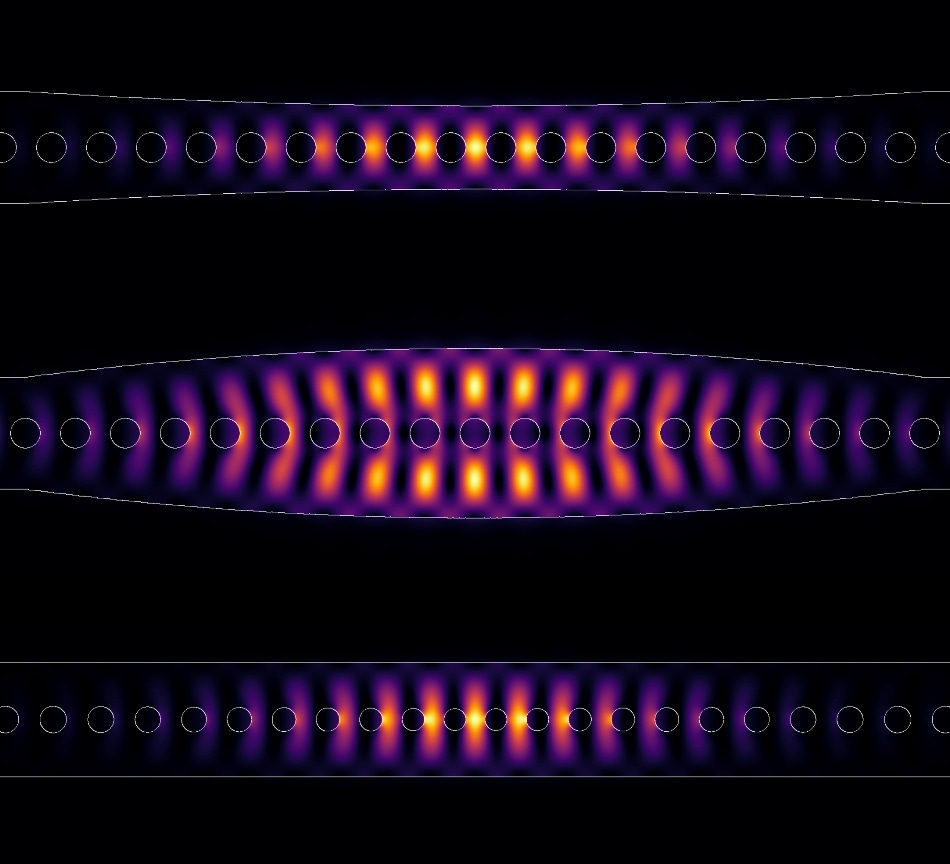Oct 11 2019
Quantum effects, which are most certainly observed in the domain of nanostructures, enable an extensive range of new technological applications. For instance, in the future, it could be possible for a quantum computer to solve problems that might take a long time for standard computers to solve.
 Various designs form photonic crystals which concentrate light in a cavity. (Image credit: ©J. Olthaus, P. Schrinner et al./Adv. Quantum Technol.)
Various designs form photonic crystals which concentrate light in a cavity. (Image credit: ©J. Olthaus, P. Schrinner et al./Adv. Quantum Technol.)
Researchers across the world are performing in-depth studies on the individual components of quantum technologies. The components include circuits capable of processing data using single photons rather than using electricity, and also light sources that create such individual quanta of light. It is specifically challenging to couple these two components to create integrated quantum optical circuits on chips.
Recently, researchers from the University of Münster created an interface that has the potential to couple light sources for single photons with nanophotonic networks. This interface is made up of photonic crystals—nanostructured dielectric materials that can improve a specific wavelength range every time light passes through. Although these photonic crystals find applications in several research areas, they had not been optimized earlier for this sort of interface.
The researchers worked hard toward accomplishing this such that it permits duplicating the photonic crystals directly by using recognized nanofabrication processes.
Our work shows that it is not only in highly specialized laboratories and unique experiments that complex quantum technologies can be produced.
Dr Carsten Schuck, Physicist and Assistant Professor, Münster University
Dr Carsten Schuck headed the research along with Dr Doris Reiter, an assistant professor, who works in the field of solid state theory. The findings could help in scaling up quantum technologies. The research was reported in the journal Advanced Quantum Technologies.
Background and Method
Single photons obey the laws of quantum physics; therefore, researchers discuss quantum emitters in terms of the light sources involved. For this study, the researchers focused on quantum emitters embedded in nanodiamonds and emitting photons upon being stimulated by electromagnetic fields. To develop the desired interfaces, the researchers aimed to create optical structures customized to the wavelength of the quantum emitters.
Holes or cavities in photonic crystals are highly suitable for capturing light in small volumes and making it interact with matter like, in this instance, nanodiamonds. Jan Olthaus, a PhD student in physics in Dr Doris Reiter’s junior research group, came up with theoretical ideas and unique computer-assisted simulation methods to compute the designs for these photonic crystals.
Physicists in the junior research group led by Dr Carsten Schuck at the Center for NanoTechnology and the Center for Soft Nanoscience at Münster University created the theoretically developed designs. PhD student Philipp Schrinner developed the crystals using a thin film of silicon nitride.
This was achieved by performing state-of-the-art electron beam lithography and exclusive etching methods using the equipment at the Münster Nanofabrication Facility. Thus, Schrinner successfully developed superior-quality crystals right on the base material of silicon dioxide.
While structuring the crystals, the researchers altered the arrangement and size of the cavities, as well as the width of the waveguide on which the cavities were positioned. The results revealed that photonic crystals which exhibited a unique variation in hole sizes were well-matched for the interfaces.
Our collaboration—between theoretical and experimental physicists—is an ideal one for physics research. This type of collaboration isn’t always easy, as our respective methods of working are often very different indeed—which is why we are all the more delighted that it turned out so well in the case of our two junior research groups.
Dr Doris Reiter, Assistant Professor, Münster University
“What’s special about our work,” adds Dr Carsten Schuck, “is that our designs don’t require any additional processing steps, because they are compatible with established thin-film technology for integrated photonic circuits.”
While creating complex quantum technologies, this cannot be taken for granted because even though researchers are usually successful in developing a significant, superior-quality component as a limited edition, they are still not able to create multiple copies of the same component all over again.
Next, as part of their goal to put the results of the research into practice, the researchers plan to position the quantum emitters, embedded in the nanodiamonds, at specific spots on the photonic crystals.
For this purpose, the team led by Dr Carsten Schuck has already started to create an exclusive nanofabrication technique capable of, for instance, placing a diamond measuring only 100 nm in size, with an accuracy of less than 50 nm.
The theoretical physicists guided by Dr Doris Reiter intend to further expand the research work to other materials systems and more complex geometries of photonic crystals, as well as to employ elliptical holes, for instance, rather than using round ones.
Funding
The Ministry of Culture and Science of the State of North Rhine-Westphalia supported the study.